Energy Reconstruction and Calibration of the MicroBooNE LArTPC
Abstract
:1. Introduction
2. Signal Processing
3. Calibration of TPC Calorimetry
4. Example Applications of Higher-Level Reconstruction Using Calorimetry
5. Conclusions
Funding
Data Availability Statement
Acknowledgments
Conflicts of Interest
References
- Acciarri, R.; Adams, C.; An, R.; Aparicio, A.; Aponte, S.; Asaadi, J.; Auger, M.; Ayoub, N.; Bagby, L.; Baller, B.; et al. Design and construction of the MicroBooNE detector. J. Instrum. 2017, 12, P02017. [Google Scholar] [CrossRef]
- Aguilar-Arevalo, A.A.; Anderson, C.E.; Bazarko, A.O.; Brice, S.J.; Brown, B.C.; Bugel, L.; Cao, J.; Coney, L.; Conrad, J.M.; Cox, D.C.; et al. Neutrino flux prediction at MiniBooNE. Phys. Rev. D 2009, 79, 072002. [Google Scholar] [CrossRef]
- Church, E.D. LArSoft: A Software Package for Liquid Argon Time Projection Drift Chambers. arXiv 2013, arXiv:1311.6774. [Google Scholar]
- Snider, E.; Petrillo, G. LArSoft: Toolkit for simulation, reconstruction and analysis of liquid argon TPC neutrino detectors. J. Phys. Conf. Ser. 2017, 898, 042057. [Google Scholar] [CrossRef]
- Agostinelli, S.; Allison, J.; Amako, K.A.; Apostolakis, J.; Araujo, H.; Arce, P.; Asai, M.; Axen, D.; Banerjee, S.; Barr, G.J.N.I.; et al. Geant4—A simulation toolkit. Nucl. Instruments Methods Phys. Res. Sect. A Accel. Spectrometers Detect. Assoc. Equip. 2003, 506, 250–303. [Google Scholar] [CrossRef]
- Allison, J.; Amako, K.; Apostolakis, J.; Arce, P.; Asai, M.; Aso, T.; Bagli, E.; Bagulya, A.; Banerjee, S.; Barr, G.J.N.I.; et al. Recent developments in Geant4. Nucl. Instruments Methods Phys. Res. Sect. A Accel. Spectrometers Detect. Assoc. Equip. 2016, 835, 186–225. [Google Scholar] [CrossRef]
- Allison, J.; Amako, K.; Apostolakis, J.E.A.; Araujo, H.A.A.H.; Dubois, P.A.; Asai, M.A.A.M.; Barr, G.A.B.G.; Capra, R.A.C.R.; Chauvie, S.A.C.S.; Chytracek, R.A.C.R.; et al. Geant4 developments and applications. IEEE Trans. Nucl. Sci. 2006, 53, 270–278. [Google Scholar] [CrossRef]
- Andreopoulos, C.; Bell, A.; Bhattacharya, D.; Cavanna, F.; Dobson, J.; Dytman, S.; Gallagher, H.; Guzowski, P.; Hatcher, R.; Kehayias, P.; et al. The GENIE Neutrino Monte Carlo Generator. Nucl. Instrum. Meth. A 2010, 614, 87–104. [Google Scholar] [CrossRef]
- Andreopoulos, C.; Barry, C.; Dytman, S.; Gallagher, H.; Golan, T.; Hatcher, R.; Perdue, G.; Yarba, J. The GENIE Neutrino Monte Carlo Generator: Physics and User Manual. arXiv 2015, arXiv:1510.05494. [Google Scholar]
- Tena-Vidal, J.; Andreopoulos, C.; Barry, C.; Dennis, S.; Dytman, S.; Gallagher, H.; Gardiner, S.; Giele, W.; Hatcher, R.; Hen, O.; et al. Hadronization model tuning in genie v3. Phys. Rev. D 2022, 105, 012009. [Google Scholar] [CrossRef]
- Tena-Vidal, J.; Andreopoulos, C.; Ashkenazi, A.; Barry, C.; Dennis, S.; Dytman, S.; Gallagher, H.; Gardiner, S.; Giele, W.; Hatcher, R.; et al. Neutrino-Nucleon Cross-Section Model Tuning in GENIE v3. Phys. Rev. 2021, 104, 072009. [Google Scholar] [CrossRef]
- Heck, D.; Knapp, J.; Capdevielle, J.N.; Schatz, G.; Thouw, T. CORSIKA: A Monte Carlo Code to Simulate Extensive Air Showers; Technical report; 51.02.03; LK 01; Wissenschaftliche Berichte, FZKA-6019 (Februar 98); Forschungszentrum Karlsruhe: Karlsruhe, Germany, 1998. [Google Scholar] [CrossRef]
- Adams, C.; An, R.; Anthony, J.; Asaadi, J.; Auger, M.; Bagby, L.; Balasubramanian, S.; Baller, B.; Barnes, C.; Barr, G.; et al. Ionization electron signal processing in single phase LArTPCs. Part I. Algorithm Description and quantitative evaluation with MicroBooNE simulation. J. Instrum. 2018, 13, P07006. [Google Scholar] [CrossRef]
- Adams, C.; An, R.; Anthony, J.; Asaadi, J.; Auger, M.; Balasubramanian, S.; Baller, B.; Barnes, C.; Barr, G.; Bass, M.; et al. Ionization electron signal processing in single phase LArTPCs. Part II. Data/simulation comparison and performance in MicroBooNE. J. Instrum. 2018, 13, P07007. [Google Scholar] [CrossRef]
- Baller, B. Liquid argon TPC signal formation, signal processing and reconstruction techniques. J. Instrum. 2017, 12, P07010. [Google Scholar] [CrossRef]
- Abratenko, P.; An, R.; Anthony, J.; Arellano, L.; Asaadi, J.; Ashkenazi, A.; Balasubramanian, S.; Baller, B.; Barnes, C.; Barr, G.; et al. Novel approach for evaluating detector-related uncertainties in a LArTPC using MicroBooNE data. Eur. Phys. J. C 2022, 82. [Google Scholar] [CrossRef]
- Abratenko, P.; An, R.; Anthony, J.; Arellano, L.; Asaadi, J.; Ashkenazi, A.; Balasubramanian, S.; Baller, B.; Barnes, C.; Barr, G.; et al. Search for an anomalous excess of charged-current νe interactions without pions in the final state with the MicroBooNE experiment. Phys. Rev. D 2022, 105, 112004. [Google Scholar] [CrossRef]
- Abratenko, P.; An, R.; Anthony, J.; Arellano, L.; Asaadi, J.; Ashkenazi, A.; Balasubramanian, S.; Baller, B.; Barnes, C.; Barr, G.; et al. Search for an anomalous excess of charged-current quasielastic νe interactions with the MicroBooNE experiment using Deep-Learning-based reconstruction. Phys. Rev. D 2022, 105, 112003. [Google Scholar] [CrossRef]
- Collaboration, M.; Abratenko, P.; An, R.; Anthony, J.; Arellano, L.; Asaadi, J.; Ashkenazi, A.; Balasubramanian, S.; Baller, B.; Barnes, C.; et al. Search for an anomalous excess of inclusive charged-current νe interactions in the MicroBooNE experiment using Wire-Cell reconstruction. Phys. Rev. D 2022, 105, 112005. [Google Scholar] [CrossRef]
- Abratenko, P.; An, R.; Anthony, J.; Arellano, L.; Asaadi, J.; Ashkenazi, A.; Balasubramanian, S.; Baller, B.; Barnes, C.; Barr, G.; et al. Search for Neutrino-Induced Neutral-Current Delta Radiative Decay in MicroBooNE and a First Test of the MiniBooNE Low Energy Excess under a Single-Photon Hypothesis. Phys. Rev. Lett. 2022, 128, 111801. [Google Scholar] [CrossRef]
- Adams, C.; Alrashed, M.; An, R.; Anthony, J.; Asaadi, J.; Ashkenazi, A.; Balasubramanian, S.; Baller, B.; Barnes, C.; Barr, G.; et al. Calibration of the charge and energy loss per unit length of the MicroBooNE liquid argon time projection chamber using muons and protons. J. Instrum. 2020, 15, P03022. [Google Scholar] [CrossRef]
- Hartnell, J.J. Measurement of the Calorimetric Energy Scale in MINOS. Ph.D. Thesis, Fermi National Accelerator Lab. (FNAL), Batavia, IL, USA, 2005. [Google Scholar] [CrossRef] [Green Version]
- Abratenko, P.; Alrashed, M.; An, R.; Anthony, J.; Asaadi, J.; Ashkenazi, A.; Balasubramanian, S.; Baller, B.; Barnes, C.; Barr, G.; et al. Measurement of space charge effects in the MicroBooNE LArTPC using cosmic muons. J. Instrum. 2020, 15, P12037. [Google Scholar] [CrossRef]
- Marshall, J.S.; Thomson, M.A. The Pandora software development kit for pattern recognition. Eur. Phys. J. C 2015, 75, 439. [Google Scholar] [CrossRef]
- Acciarri, R.; Adams, C.; An, R.; Anthony, J.; Asaadi, J.; Auger, M.; Bagby, L.; Balasubramanian, S.; Baller, B.; Barnes, C.; et al. The Pandora multi-algorithm approach to automated pattern recognition of cosmic-ray muon and neutrino events in the MicroBooNE detector. Eur. Phys. J. C 2018, 78, 82. [Google Scholar] [CrossRef]
- Acciarri, R.; Adams, C.; Asaadi, J.; Baller, B.; Bolton, T.; Bromberg, C.; Cavanna, F.; Church, E.; Edmunds, D.; Ereditato, A.; et al. A study of electron recombination using highly ionizing particles in the ArgoNeuT Liquid Argon TPC. J. Instrum. 2013, 8, P08005. [Google Scholar] [CrossRef]
- Pernegger, H.; Friedl, M. Convoluted Landau and Gaussian Fitting Function. Available online: https://root.cern/doc/master/langaus_8C.html (accessed on 9 October 2019).
- Bichsel, H. Straggling in thin silicon detectors. Rev. Mod. Phys. 1988, 60, 663–699. [Google Scholar] [CrossRef]
- Groom, D.E.; Mokhov, N.V.; Striganov, S.I. Muon Stopping Power and Range Tables 10 MeV–100 TeV. At. Data Nucl. Data Tables 2001, 78, 183–356. [Google Scholar] [CrossRef]
- Abratenko, P.; An, R.; Anthony, J.; Asaadi, J.; Ashkenazi, A.; Balasubramanian, S.; Baller, B.; Barnes, C.; Barr, G.; Basque, V.; et al. Calorimetric classification of track-like signatures in liquid argon TPCs using MicroBooNE data. J. High Energy Phys. 2021, 2021. [Google Scholar] [CrossRef]
- Abratenko, P.; An, R.; Anthony, J.; Arellano, L.; Asaadi, J.; Ashkenazi, A.; Balasubramanian, S.; Baller, B.; Barnes, C.; Barr, G.; et al. Electromagnetic shower reconstruction and energy validation with Michel electrons and π0 samples for the deep-learning-based analyses in MicroBooNE. J. Instrum. 2021, 16, T12017. [Google Scholar] [CrossRef]
- Frühwirth, R. Application of Kalman filtering to track and vertex fitting. Nucl. Instruments Methods Phys. Res. Sect. A Accel. Spectrometers Detect. Assoc. Equip. 1987, 262, 444–450. [Google Scholar] [CrossRef]
- Abratenko, P.; An, R.; Anthony, J.; Arellano, L.; Asaadi, J.; Ashkenazi, A.; Balasubramanian, S.; Baller, B.; Barnes, C.; Barr, G.; et al. First measurement of inclusive electron-neutrino and antineutrino charged current differential cross sections in charged lepton energy on argon in MicroBooNE. Phys. Rev. D 2022, 105, L051102. [Google Scholar] [CrossRef]
- Abratenko, P.; An, R.; Anthony, J.; Arellano, L.; Asaadi, J.; Ashkenazi, A.; Balasubramanian, S.; Baller, B.; Barnes, C.; Barr, G.; et al. First Measurement of Energy-Dependent Inclusive Muon Neutrino Charged-Current Cross Sections on Argon with the MicroBooNE Detector. Phys. Rev. Lett. 2022, 128, 151801. [Google Scholar] [CrossRef] [PubMed]

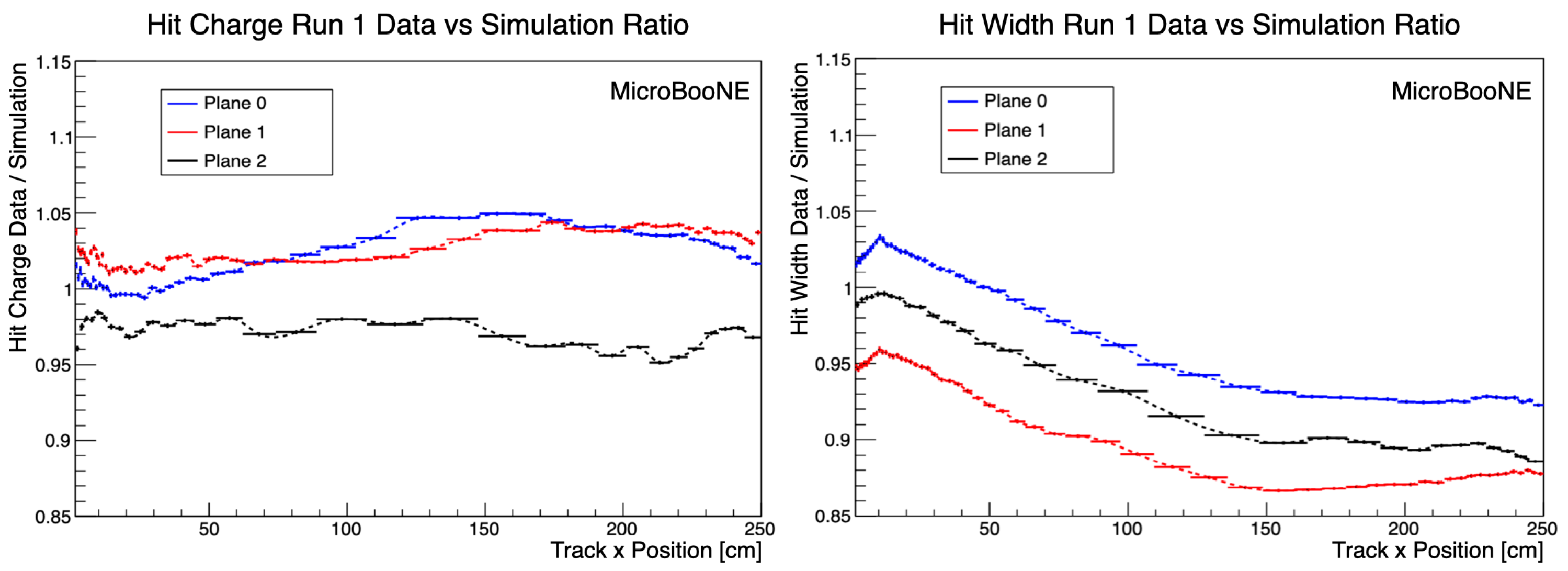
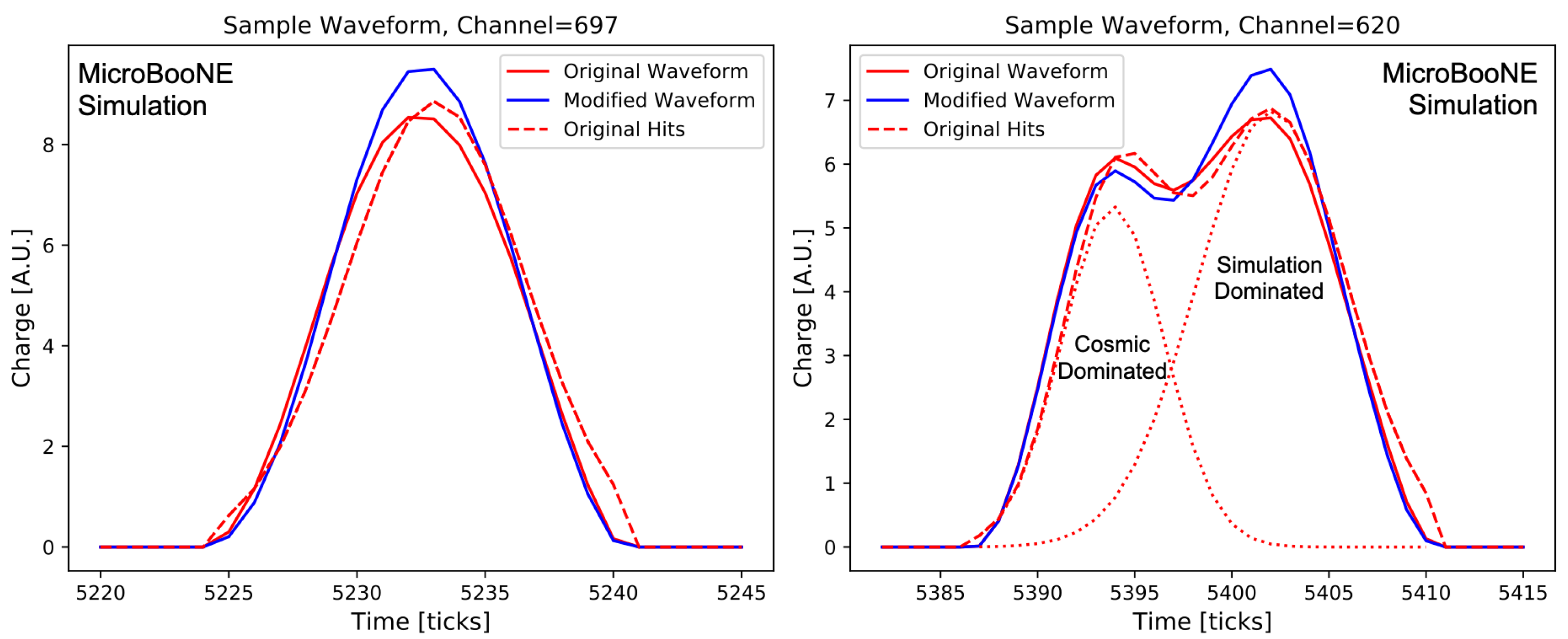

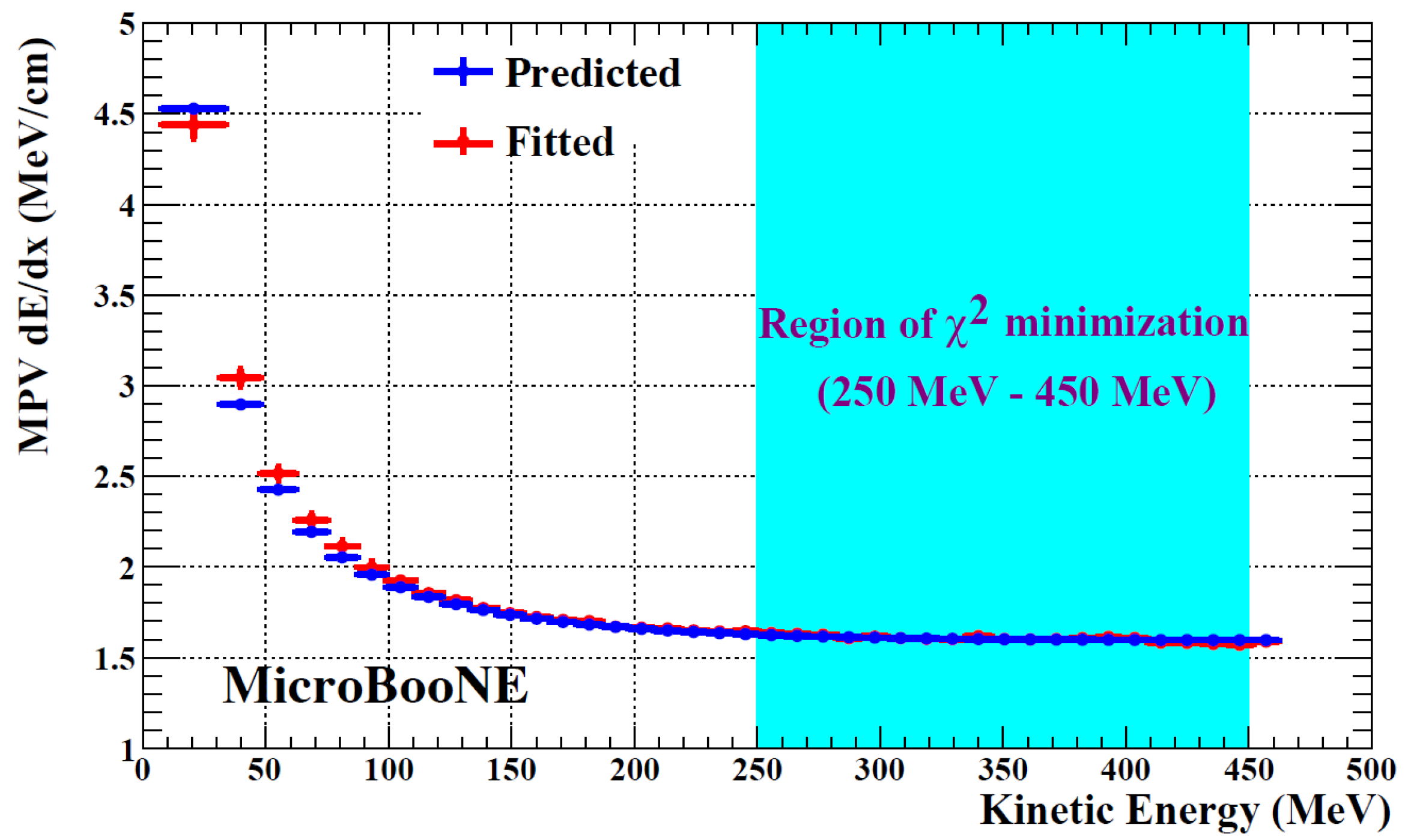
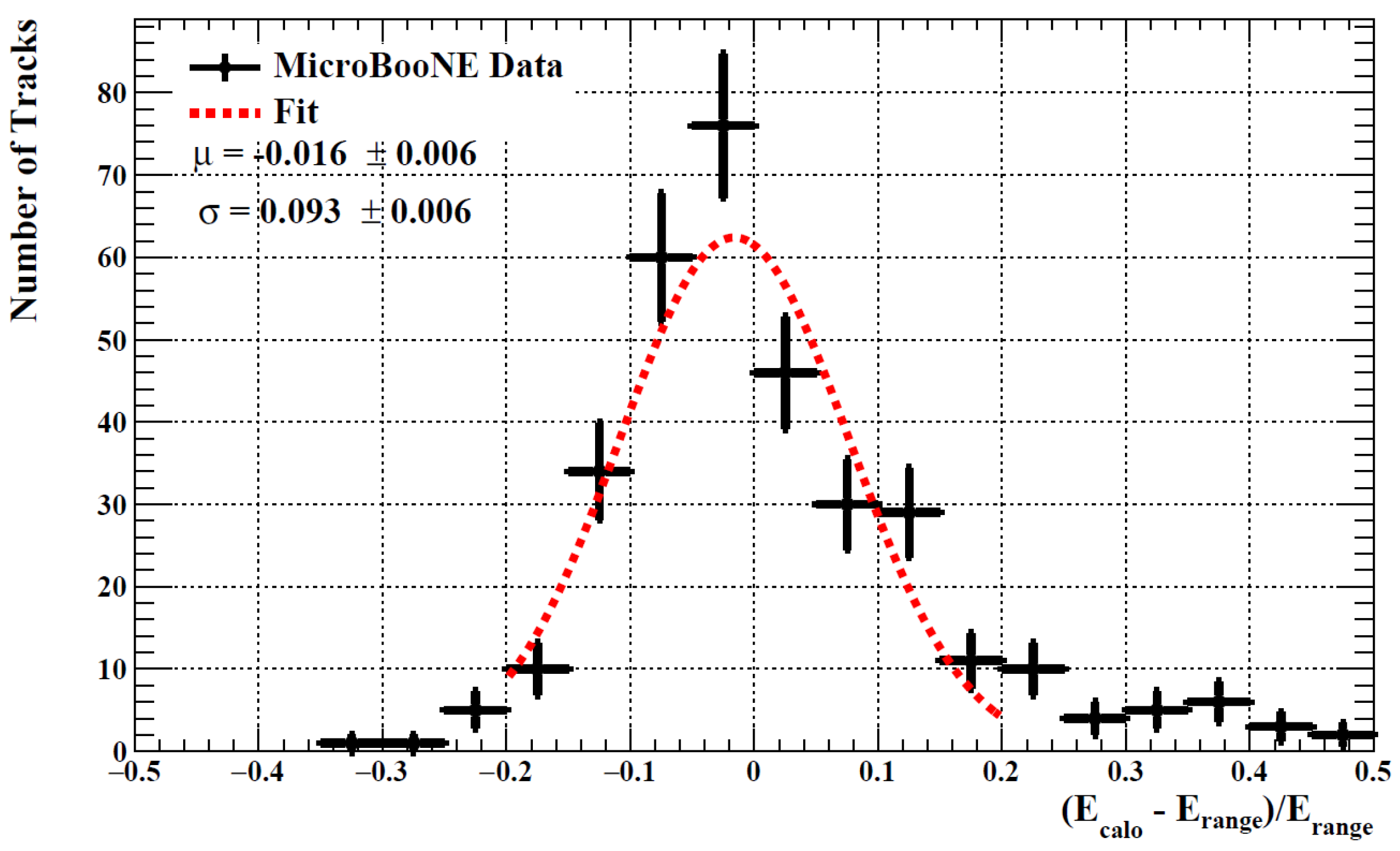
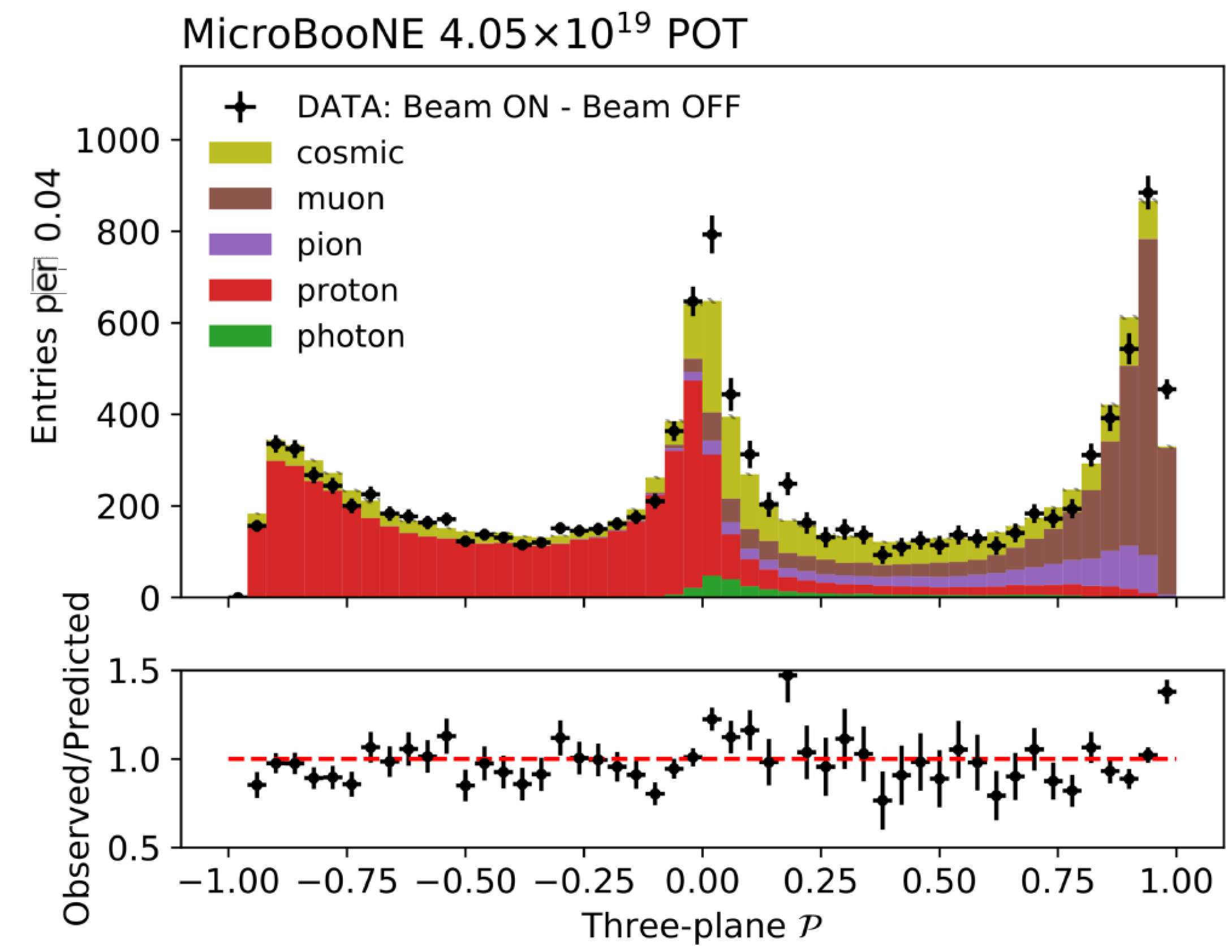
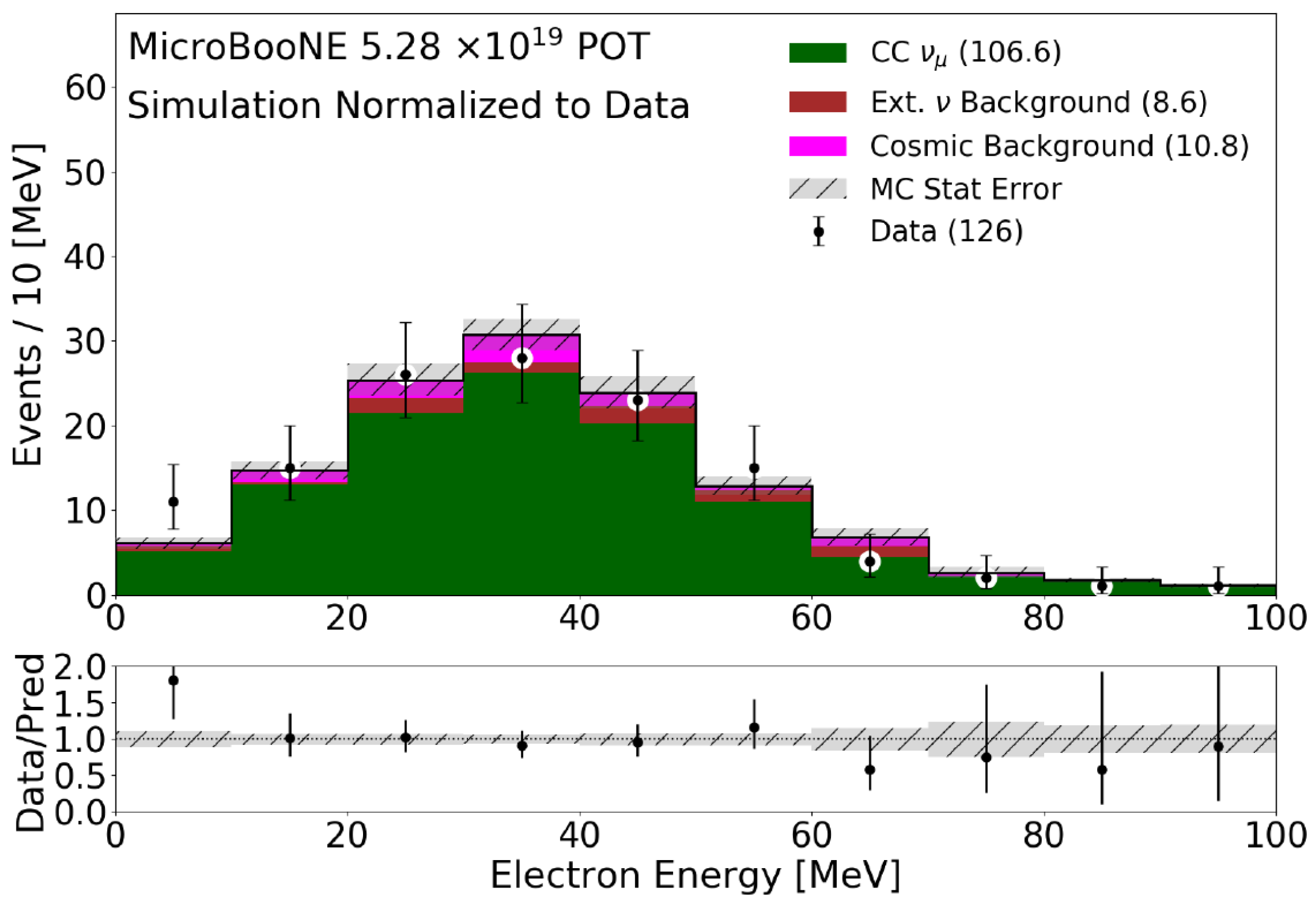
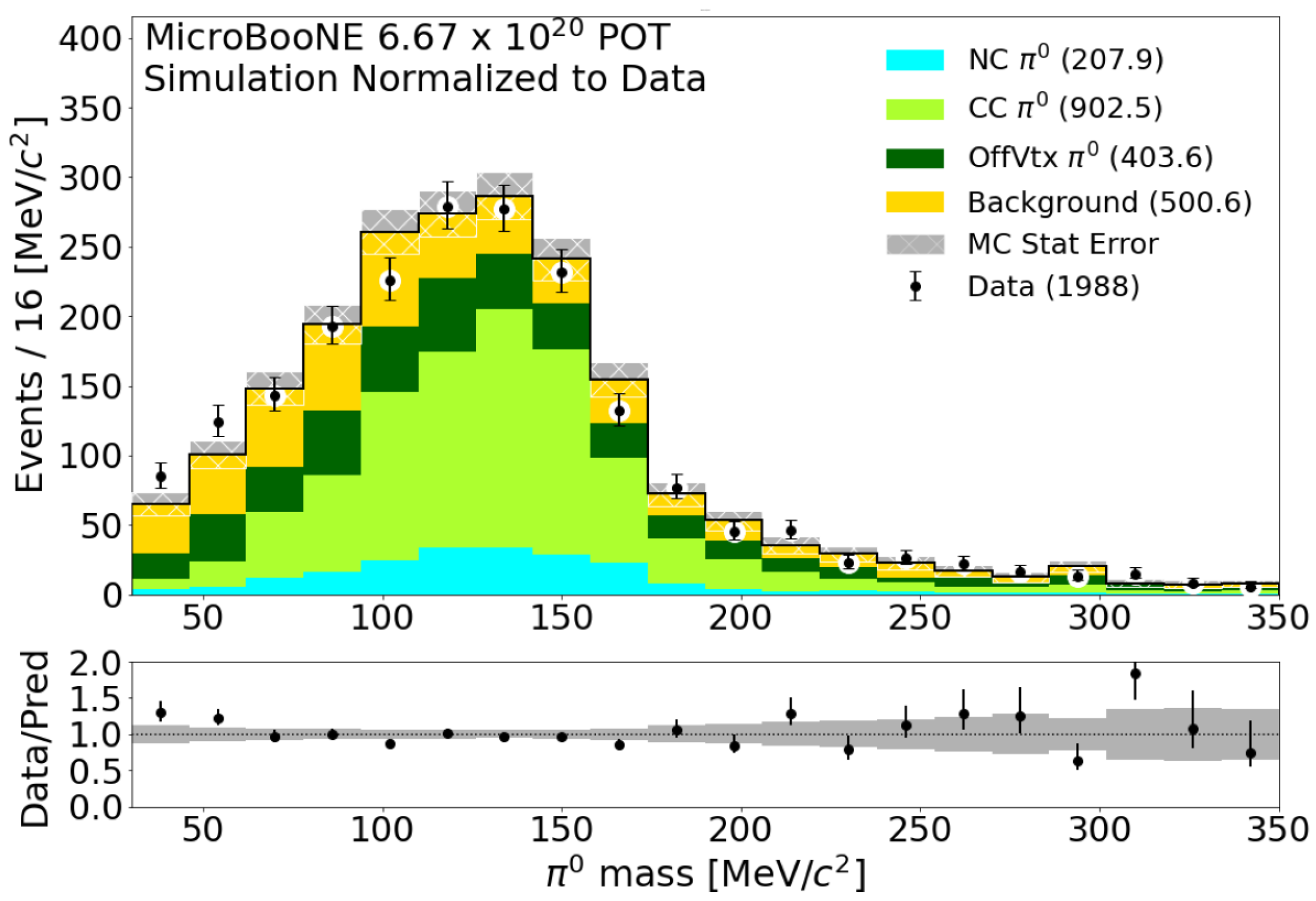
Publisher’s Note: MDPI stays neutral with regard to jurisdictional claims in published maps and institutional affiliations. |
© 2022 by the author. Licensee MDPI, Basel, Switzerland. This article is an open access article distributed under the terms and conditions of the Creative Commons Attribution (CC BY) license (https://creativecommons.org/licenses/by/4.0/).
Share and Cite
Diurba, R., on behalf of the MicroBooNE Collaboration. Energy Reconstruction and Calibration of the MicroBooNE LArTPC. Instruments 2022, 6, 30. https://doi.org/10.3390/instruments6030030
Diurba R on behalf of the MicroBooNE Collaboration. Energy Reconstruction and Calibration of the MicroBooNE LArTPC. Instruments. 2022; 6(3):30. https://doi.org/10.3390/instruments6030030
Chicago/Turabian StyleDiurba, Richard on behalf of the MicroBooNE Collaboration. 2022. "Energy Reconstruction and Calibration of the MicroBooNE LArTPC" Instruments 6, no. 3: 30. https://doi.org/10.3390/instruments6030030
APA StyleDiurba, R., on behalf of the MicroBooNE Collaboration. (2022). Energy Reconstruction and Calibration of the MicroBooNE LArTPC. Instruments, 6(3), 30. https://doi.org/10.3390/instruments6030030






